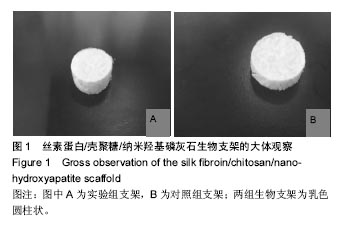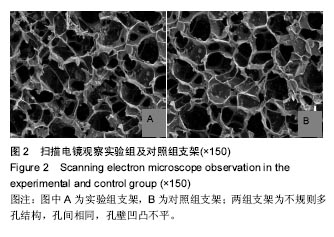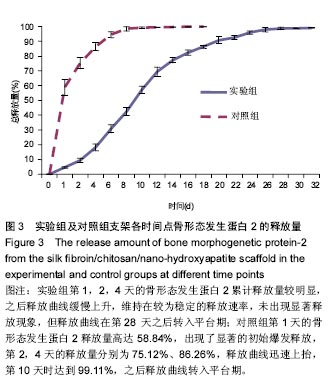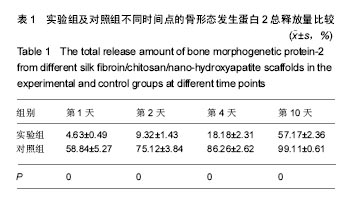| [1]Silva AM,Souza WM,Koivisto MB,et al.Miniplate fixation for the repair of segmental mandibular defects filled with autogenous bone in cats.Acta Cir Bras. 2011;26(3): 174-180.[2]Jiang WR,Zhang X,Liu YS,et al.A novel tissue-engineered bone constructed by using human adipose-derived stem cells and biomimetic calcium phosphate scaffold coprecipitated with bone morphogenetic protein-2.Beijing Da Xue Xue Bao. 2017;49(1):6-15.[3]Zhang X,Guo WG,Cui H,et al.In vitro and in vivo enhancement of osteogenic capacity in a synthetic BMP-2 derived peptide-coated mineralized collagen composite.J Tissue Eng Regen Med.2016;10(2):99-107.[4]Perez RA,Kim JH,Buitrago JO,et al.Novel therapeutic core-shell hydrogel scaffolds with sequential delivery of cobalt and bone morphogenetic protein-2 for synergistic bone regeneration.Acta Biomater.2015;23:295-308.[5]金光辉,张馨雯,孙晓飞,等.组织工程化纳米羟基磷灰石/聚己内酯人工骨支架修复兔桡骨大段骨缺损的实验研究[J].中华损伤与修复杂志(电子版),2015,10(1):43-49.[6]Deng J,She R,Huang W,et al.A silk fibroin/chitosan scaffold in combination with bone marrow-derived mesenchymal stem cells to repair cartilage defects in the rabbit knee.J Mater Sci Mater Med.2013;24(8):2037-2046.[7]Bandyopadhyay A,Tsuji K,Cox K,et al.Genetic analysis of the roles of BMP2, BMP4, and BMP7 in limb patterning and skeletogenesis.PLoS Genet.2006;2(12):2116-2130.[8]Takahashi Y,Yamamoto M,Tabata Y.Enhanced osteoinduction by controlled release of bone morphogenetic protein-2 from biodegradable sponge composed of gelatin and beta-tricalcium phosphate. Biomaterials,2005,26(23): 4856-4865.[9]叶鹏,田仁元,黄文良,等.丝素/壳聚糖/纳米羟基磷灰石构建的骨组织工程支架[J].中国组织工程研究,2013,17(29): 5269-5274.[10]马立坤,叶鹏,邓江,等.丝素蛋白/壳聚糖/纳米羟基磷灰石骨组织工程支架材料的体外细胞毒性评价[J]. 西部医学,2014,26(8): 975-977.[11]Deng J,She RF,Huang WL,et al.Fibroin protein/chitosan scaffolds and bone marrow mesenchymal stem cells culture in vitro.Genet Mol Res.2014;13(3):5745-5753.[12]Meijer GJ,de Bruijn JD,Koole R,et al.Cell-based bone tissue engineering.PLoS Med.2007;4(2):260-264.[13]Vural AC,Odabas S,Korkusuz P,et al.Cranial bone regeneration via BMP-2 encoding mesenchymal stem cells.Artif Cells Nanomed Biotechnol.2017;45(3):544-550.[14]Seo BB,Koh JT,Song SC.Tuning physical properties and BMP-2 release rates of injectable hydrogel systems for an optimal bone regeneration effect.Biomaterials.2017;122: 91-104.[15]Zhou J,Guo X,Zheng Q,et al.Improving osteogenesis of three-dimensional porous scaffold based on mineralized recombinant human-like collagen via mussel-inspired polydopamine and effective immobilization of BMP-2-derived peptide. Colloids Surf B Biointerfaces.2017; 152:124-132.[16]Maksimkin AV,Senatov FS,Anisimova NY,et al.Multilayer porous UHMWPE scaffolds for bone defects replacement. Mater Sci Eng C Mater Biol Appl.2017;73:366-372.[17]Yu WL,Sun TW,Qi C,et al.Enhanced osteogenesis and angiogenesis by mesoporous hydroxyapatite microspheres- derived simvastatin sustained release system for superior bone regeneration.Sci Rep. 2017;7: 44129-44116.[18]刘昊,张永刚.骨组织工程的研究应用与进展[J].生物骨科材料与临床研究,2012,9(2):32-34.[19]丁立峰,周振东,杨军,等.骨形态发生蛋白2基因转染的兔骨髓间充质干细胞复合聚乳酸-聚己内酯支架体外构建载基因仿生骨的实验研究[J].中国矫形外科杂志,2013,21(9):918-923.[20]Schmidmaier G,Schwabe P,Strobel C,et al.Carrier systems and application of growth factors in orthopaedics.Injury.2008; 2(39):S37-S80.[21]Hong SJ,Yu HS,Kim HW.Tissue engineering polymeric microcarriers with macroporous morphology and bone-bioactive surface.Macromol Biosci.2009;9(7):639-645.[22]肖振涛,郭中凯,郭立新.基因强化骨组织工程中的病毒载体[J].中国组织工程研究,2015,19(2):272-276.[23]刘泉.基因修饰骨髓间充质干细胞在骨组织工程中的应用现状[J].现代口腔医学杂志,2015,29(3):172-175.[24]郭宜姣,李文华.骨缺损修复生物工程研究进展[J].中国骨质疏松杂志,2014,20(8):988-993.[25]Ranjbar-Mohammadi M, Zamani M, Prabhakaran MP, et al. Electrospinning of PLGA/gum tragacanth nanofibers containing tetracycline hydrochloride for periodontal regeneration. Mater Sci Eng C Mater Biol Appl, 2016;58: 521-531.[26]Sandler N,Salmela I,Fallarero A,et al.Towards fabrication of 3D printed medical devices to prevent biofilm formation.Int J Pharm.2014;459(1-2):62-64. [27]Rambhia KJ,Ma PX.Controlled drug release for tissue engineering.J Control Release.2015;10(219):119-128.[28]马立坤,邓江,叶鹏,等.携重组人骨形态发生蛋白2聚乳酸缓释微球的生物支架复合自体松质骨修复骨缺损[J].现代预防医学, 2015,42(5):882-885.[29]Krishnan AG,Jayaram, L,Biswas R,et al.Evaluation of antibacterial activity and cytocompatibility of ciprofloxacin loaded gelatin-hydroxyapatite scaffolds as a local drug delivery system for osteomyelitis treatment.Tissue Eng Part A.2015;21(7-8):1422-1431.[30]Fan M,Ma Y,Tan H,et al.Covalent and injectable chitosan-chondroitin sulfate hydrogels embedded with chitosan microspheres for drug delivery and tissue engineering.Mater Sci Eng C Mater Biol Appl.2017;71:67-74.[31]Naderi-Meshkin H,Andreas K,Matin MM,et al.Chitosan-based injectable hydrogel as a promising in situ forming scaffold for cartilage tissue engineering.Cell Biol Int.2014;38(1):72-84.[32]Upadhyaya L,Singh J,Agarwal V,et al.The implications of recent advances in carboxymethyl chitosan based targeted drug delivery and tissue engineering applications.J Control Release.2014;186:54-87.[33]Kaiser E,Jaganathan SK,Supriyanto E,et al.Fabrication and characterization of chitosan nanoparticles and collagen-loaded polyurethane nanocomposite membrane coated with heparin for atrial septal defect (ASD) closure.3 Biotech.2017;7(3):174. [34]Wu S,Pan H,Tan S,et al.<i>In vitro</i> inhibition of lipid accumulation induced by oleic acid and <i>in vivo</i> pharmacokinetics of chitosan microspheres (CTMS) and chitosan-capsaicin microspheres (CCMS).Food Nutr Res.2017;61(1):1331658. [35]De Angelis E,Ravanetti F,Martelli P,et al.The in vitro biocompatibility of d-(+) raffinose modified chitosan: Two-dimensional and three-dimensional systems for culturing of horse articular chondrocytes.Res Vet Sci.2017;115: 310-317. [36]Shen Z,Xu K,Wang H,et al.Experimental research of neutrophil gelatinase-associated lipocalin siRNA encapsulated by urocanic acid-coupled chitosan on colon cancer cells.Zhonghua Wei Chang Wai Ke Za Zhi. 2017; 20(6):694-700. [37]Wang S,Li Y,Zhao R,et al.Chitosan surface modified electrospun poly(ε-caprolactone)/carbon nanotube composite fibers with enhanced mechanical, cell proliferation and antibacterial properties.Int J Biol Macromol.2017;104(Pt A):708-715. [38]Hu Z,Chen J,Zhou S,et al.Mouse IP-10 Gene Delivered by Folate-modified Chitosan Nanoparticles and Dendritic/tumor Cells Fusion Vaccine Effectively Inhibit the Growth of Hepatocellular Carcinoma in Mice.Theranostics. 2017; 7(7):1942-1952. [39]Wang C,Hou W,Guo X,et al.Two-phase electrospinning to incorporate growth factors loaded chitosan nanoparticles into electrospun fibrous scaffolds for bioactivity retention and cartilage regeneration.Mater Sci Eng C Mater Biol Appl. 2017;79:507-515. [40]Elshaarawy RFM,Mustafa FHA,van Geelen L,et al.Mining marine shell wastes for polyelectrolyte chitosan anti-biofoulants: Fabrication of high-performance economic and ecofriendly anti-biofouling coatings.Carbohydr Polym. 2017;172:352-364. [41]Wu J,Feng S,Liu W,et al.Targeting integrin-rich tumors with temoporfin-loaded vitamin-E-succinate-grafted chitosan oligosaccharide/d-α-tocopheryl polyethylene glycol 1000 succinate nanoparticles to enhance photodynamic therapy efficiency.Int J Pharm.2017;528(1-2):287-298.[42]Liu B,Luo J,Wang X,et al.Alginate/quaternized carboxymethyl chitosan/clay nanocomposite microspheres: preparation and drug-controlled release behavior.J Biomater Sci Polym Ed. 2013;24(5):589-605.[43]Murphy CM,Haugh MG,O'Brien FJ.The effect of mean pore size on cell attachment, proliferation and migration in collagen-glycosaminoglycan scaffolds for bone tissue engineering. Biomaterials.2010;31(3):461-466.[44]叶鹏,马立坤,黄文良,等.骨组织工程三维复合支架修复兔桡骨骨缺损[J].中国组织工程研究,2014,18(3):383-388. |
.jpg)




.jpg)